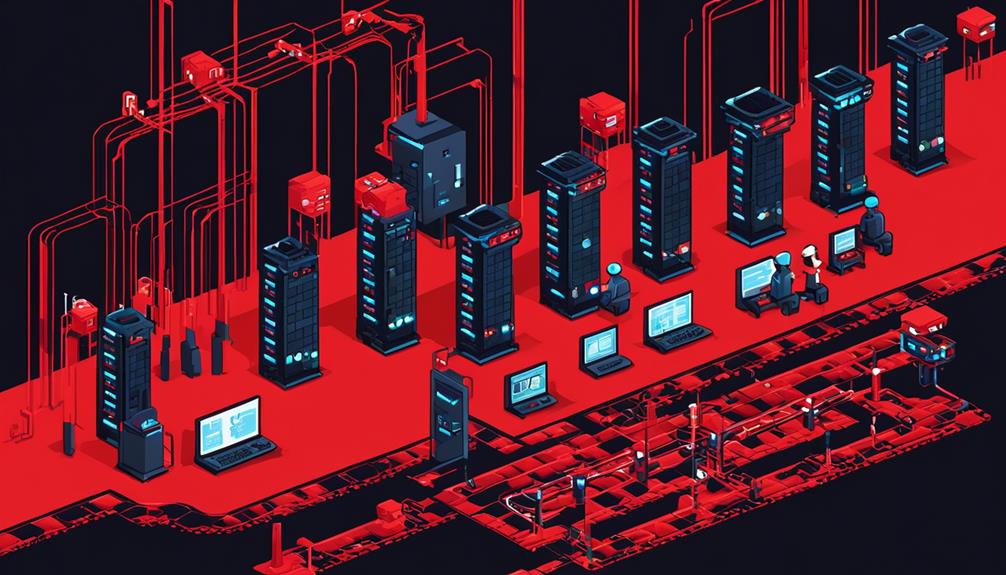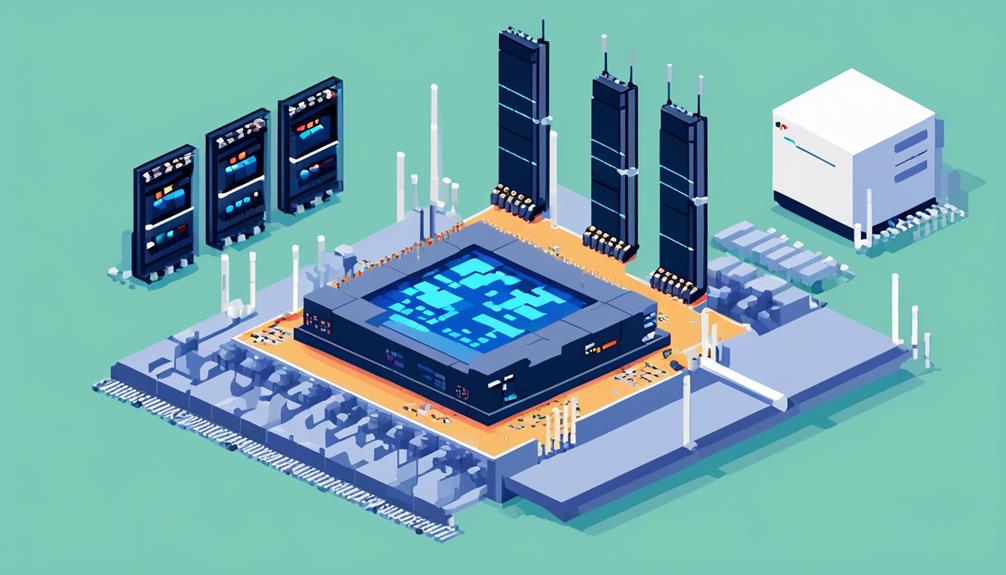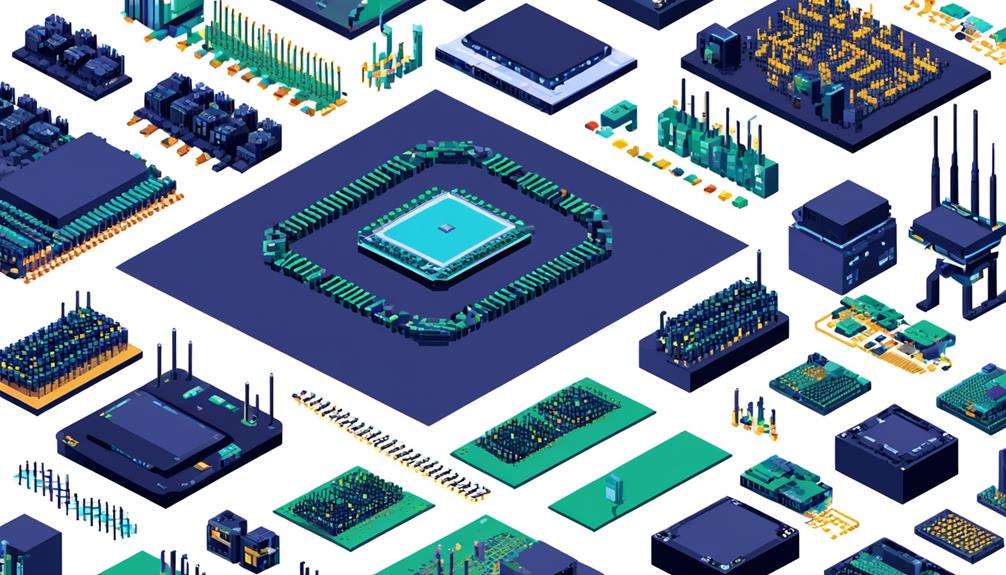The rapid advancement of telecommunications networks has led to an increasing demand for edge computing hardware. As telco service providers strive to enhance performance and reduce latency, the deployment of edge computing solutions has become a critical aspect of network modernization.
This discussion aims to explore the role of edge computing hardware in telecommunications, specifically focusing on virtualizing network functions, leveraging open radio access networks (RAN), and the approach taken by Red Hat in enabling edge deployments.
By understanding the drivers and opportunities presented by edge computing, we can gain insights into how it revolutionizes telecom infrastructure, paving the way for transformative technologies such as IoT, AI, and AR. Join us on this journey as we delve into the future of edge computing in telecommunications and its potential to reshape the industry.
Key Takeaways
- Telco network modernization and adoption of edge technologies, such as virtualized network functions, are crucial for enhancing network operations and optimizing flexibility, reliability, and scalability.
- Transitioning to 5G networks is made easier with the implementation of Open Radio Access Networks (RAN) and virtualized RAN (vRAN), which reduce costs, promote interoperability, and improve scalability.
- Cloud-native and container-based solutions offer cost reductions, reduce vendor lock-in, and support more devices and bandwidth-hungry applications, while abstraction of functions from hardware and use of standard servers enhance flexibility and efficiency.
- Network Functions Virtualization (NFV) plays a vital role in achieving scalability, agility, and cost-effectiveness, enabling quick deployment of new services, resource scaling based on demand, and optimization of network operations.
Telco Network Modernizations

Telco Network Modernizations aim to enhance network operations and optimize flexibility, availability, efficiency, reliability, and scalability in the telecommunications industry. As telecom providers strive to meet the increasing demands of their customers, they are turning to telco network modernizations to improve their network infrastructure and provide better services. One of the key aspects of these modernizations is the adoption of edge technologies.
By leveraging edge technologies, such as virtualized network functions, telecom providers can abstract functions from hardware and improve scalability and agility. This allows them to quickly deploy new services and respond to changing customer needs. Additionally, the transition to 5G networks is made easier with the use of Open Radio Access Networks (RAN) and virtualized RAN (vRAN). These technologies simplify network operations, improve flexibility, and increase efficiency.
Cloud-native and container-based solutions are also playing a significant role in telco network modernizations. These solutions offer lower costs, reduce vendor lock-in, and support an increasing number of devices and bandwidth-hungry applications. By adopting these technologies, telecom providers can better meet the demands of their customers and stay competitive in the market.
Furthermore, telcos can leverage edge computing to derive revenue from future computing and connectivity infrastructure. By expanding their market leadership and offering value-added services, they can drive revenue streams and manage the complexity of their networks. Edge computing allows telecom providers to bring computing capabilities closer to the end-users, enabling faster and more efficient processing of data.
Virtualizing Network Functions
Virtualizing network functions brings several benefits to telecommunications.
Firstly, it allows for the abstraction of functions from hardware, enabling the use of standard servers and reducing reliance on proprietary hardware.
Secondly, it enables the implementation of Network Functions Virtualization (NFV), which enhances scalability and agility for service providers.
Lastly, virtualizing network functions can lead to cost reductions, improved performance, and increased efficiency in telco operations.
NFV Benefits
Network Functions Virtualization (NFV) offers telcos the opportunity to enhance agility and scalability by abstracting functions from hardware. By implementing NFV, telcos can use standard servers, reducing reliance on expensive proprietary hardware.
NFV applies enterprise IT virtualization to network functions, enhancing flexibility and efficiency. For the transition to 5G, virtualizing RAN (vRAN) is essential as it simplifies network operations and improves scalability.
The benefits of NFV for telcos include improved scalability, agility, and cost-effectiveness. By virtualizing network functions, telcos can quickly deploy new services and scale resources based on demand. This flexibility allows them to meet the growing needs of edge computing in telecommunications, enabling faster and more efficient data processing at the network edge.
Performance Improvements
Performance improvements can be achieved through the abstraction of functions from hardware in order to enhance efficiency and flexibility in network operations.
Virtualizing network functions is a key approach to achieving these improvements. By abstracting functions from proprietary hardware and utilizing standard servers, edge computing hardware in telecommunications can deliver enhanced performance.
Network Functions Virtualization (NFV) applies enterprise IT virtualization techniques to network functions, resulting in improved overall performance. Containers provide another efficient method to abstract functions from hardware, further enhancing performance.
NFV also offers scalability and agility benefits for service providers, which positively impact performance. By leveraging virtualization technologies and adopting NFV, telecommunications companies can optimize their network operations and deliver higher performance to their customers.
Cost Reductions
With the optimization of network operations and the utilization of virtualization technologies, telecommunications providers can achieve significant cost reductions by abstracting functions from expensive proprietary hardware.
Virtualizing network functions allows telcos to move away from relying on costly hardware and instead use standard servers, reducing expenses.
Network functions virtualization (NFV) plays a crucial role in this cost reduction strategy, enabling telcos to virtualize various functions and deploy them on virtual machines.
Additionally, virtualizing the Radio Access Network (vRAN) enhances scalability and agility, further reducing costs for service providers.
Containers offer a more efficient way to abstract functions from hardware, improving cost-effectiveness by providing lightweight virtualization.
Open Radio Access Networks (Ran)
Open Radio Access Networks (RAN), essential connection points between end-user devices and telco networks, play a crucial role in the transition to 5G by virtualizing RAN (vRAN) and offering improved network operations, flexibility, and efficiency. As the telecommunications industry moves towards edge computing, open RAN solutions are gaining prominence due to their ability to simplify network operations and enhance flexibility.
One of the key advantages of open RAN is its ability to virtualize the RAN, enabling the deployment of cloud-native and container-based solutions. This approach offers several benefits to the telecommunications industry. Firstly, it reduces costs by leveraging commodity hardware and open-source software, eliminating the need for expensive proprietary equipment. Secondly, it reduces vendor lock-in by promoting interoperability and allowing operators to choose best-of-breed solutions from different vendors.
By adopting open RAN, telco operators can also address the increasing number of devices and bandwidth-hungry applications. Open RAN solutions can scale to accommodate the growing demand for connectivity and support the diverse requirements of IoT devices, autonomous vehicles, and smart cities.
Moreover, open RAN paves the way for innovation and competition in the telecommunications industry. It enables smaller vendors and start-ups to enter the market, driving technological advancements and ensuring a more competitive landscape.
Red Hat's Approach to Edge Computing

Red Hat's approach to edge computing focuses on efficiently managing and scaling edge solutions for telecommunications providers. Their edge technologies are designed to be managed using existing tools and processes, ensuring a seamless integration with the telco environment. Automation plays a crucial role in Red Hat's approach, enabling the provisioning, management, and orchestration of edge sites. This automation streamlines operations and reduces manual effort, allowing telco providers to rapidly deploy and scale their edge infrastructure.
To further enhance the effectiveness of their edge computing solutions, Red Hat prioritizes interoperability among components from various vendors. This ensures that telco providers have the flexibility to choose the best-in-class hardware and software components for their specific requirements, while still benefiting from Red Hat's robust management and orchestration capabilities.
Red Hat offers open hybrid cloud solutions for edge deployments, including their renowned Red Hat Enterprise Linux (RHEL) and OpenShift platforms. These platforms provide a reliable and secure foundation for edge computing, enabling telco providers to leverage their existing infrastructure and build upon it with edge-specific capabilities.
With Red Hat's edge computing solutions, telco providers can effectively manage data storage, processing, and storage at the edge, ensuring low latency and high availability for their critical applications.
Multi-Access Edge Computing (Mec)
Multi-Access Edge Computing (MEC) offers numerous benefits in the telecommunications industry. It brings computing resources closer to users and devices, reducing latency and improving application response times.
MEC architecture overview involves leveraging virtualization technologies and open radio access networks (RAN) to simplify network operations, enhance scalability and agility, and support the transition to 5G.
Additionally, MEC supports a wide range of use cases in telecommunications, including IoT, augmented reality, reliability enhancement, cost reduction, and operational efficiency.
Benefits of MEC
The benefits of Multi-Access Edge Computing (MEC) include reduced latency, enhanced user experience, efficient utilization of network resources, seamless data transmission, and empowerment for critical decision-making through near real-time data analysis.
Reduced latency allows for improved application response times, ensuring smooth and seamless user experiences.
Enhanced user experience is achieved through real-time data analysis, enabling personalized and context-aware services.
Efficient utilization of network resources is possible with MEC's ability to optimize bandwidth, leading to cost savings and improved network performance.
Seamless data transmission is facilitated by robust telecommunications infrastructure, ensuring uninterrupted connectivity and data flow.
MEC empowers critical decision-making by providing near real-time data analysis, enabling businesses to make informed and timely decisions.
These benefits highlight the significant advantages that MEC offers in leveraging edge computing hardware for telecommunications.
MEC Architecture Overview
MEC Architecture Overview (Multi-Access Edge Computing (MEC)) brings the computing capabilities closer to the network edge, enabling telcos to deploy applications and services at the edge for faster data processing and improved latency and performance.
MEC leverages edge servers located in close proximity to end-users, reducing the distance data needs to travel. This proximity minimizes the latency associated with transmitting data to and from a centralized cloud.
MEC architecture supports various access technologies such as 5G, Wi-Fi, and LTE, allowing telcos to leverage the most suitable connectivity options for their edge deployments.
MEC Use Cases
MEC Use Cases in the telecommunications industry encompass various applications and services that leverage edge computing capabilities to improve operational efficiency and deliver real-time insights. These use cases highlight the significant impact of MEC on the telecom sector:
- Facilitating IoT technology for supply chain insights and real-time asset performance monitoring.
- Utilizing data from IoT sensors in augmented reality (AR) for hardware inspections and troubleshooting.
- Enhancing network resiliency and minimizing failure impact through decentralized processing.
- Enabling predictive maintenance to reduce costs associated with network and equipment faults.
With edge computing at the forefront, MEC enables telecom operations to process data closer to the source, increasing efficiency and enabling the delivery of real-time insights.
These use cases demonstrate the transformative power of MEC in revolutionizing telecommunications.
Iot and Edge Computing
With the rise of the Internet of Things (IoT), the integration of edge computing has become imperative for enabling real-time data analysis and achieving faster response times. Edge computing brings processing and storage capabilities closer to the IoT devices and sensors, reducing network latency and bandwidth usage. This is particularly important in the telecommunications industry, where large amounts of data are generated and transmitted continuously.
Edge computing enhances the security and privacy of IoT data by keeping sensitive information closer to the source. Instead of sending data to a centralized cloud server, edge devices can process and analyze data locally, minimizing the risk of data breaches. This is especially critical in telecommunications, where data privacy and security are paramount.
Furthermore, edge computing enables faster processing and reduced data transfer, allowing real-time applications and services to operate efficiently. In the context of IoT, this means that devices can make decisions and respond to events in real-time, without relying on a distant cloud server. This is particularly beneficial in time-critical scenarios, such as autonomous vehicles or industrial automation, where immediate actions are required based on real-time data analysis.
What Is Edge Computing?

Edge computing is a distributed computing paradigm that brings data processing and storage closer to the source of data generation. By reducing latency and improving response times, it enables real-time data analysis and enhances the end-user experience.
Additionally, edge computing supports a wide range of applications, including robotics, AI, IoT, and AR, by providing the necessary connectivity speeds and enabling advanced technologies.
Definition of Edge Computing
Edge computing is a distributed computing architecture framework that brings processing closer to the source of data generation and consumption, resulting in reduced latency and improved end-user experience. It enables real-time data analysis, reducing network latency and bandwidth usage, and enhancing the security and privacy of IoT data.
Edge computing supports applications requiring higher connectivity speeds, coupled with 5G, for advanced technologies like robotics, AI, IoT, and AR. Telecom companies benefit from edge computing use cases such as IoT for supply chain insights, AR for hardware inspections, and reliability for enhanced network resiliency and cost reduction through predictive maintenance.
This technology provides revenue generation, market leadership, complexity management, value chain expansion, and partnership opportunities for telecom companies. With edge computing, processing and storage are brought closer to the edge, enabling faster and more efficient data processing and analysis.
Benefits of Edge Computing
The advantages of edge computing extend beyond reduced latency and improved end-user experience in the telecommunications industry.
Edge computing enables telcos to process and store data closer to users and devices, resulting in enhanced performance and faster application response times. This capability supports real-time data analysis and faster response times, which are crucial for telecom operations.
Additionally, telcos can leverage their expertise and existing infrastructure to drive revenue and achieve market leadership through edge computing. By modernizing their networks and adopting edge computing technologies, telcos can generate new revenue sources and provide innovative services to their customers.
In summary, the benefits of edge computing in the telecommunications industry include:
- Improved performance
- Real-time data analysis
- Faster response times
- Revenue generation
- Market leadership
Applications of Edge Computing
With the increasing demand for low-latency and high-performance applications, edge computing has emerged as a pivotal technology in the telecommunications industry. Telecommunications service providers are adopting edge computing to modernize their networks and create new revenue streams.
By moving workloads and services closer to users and devices, edge computing reduces latency and improves application response times. This enables real-time data analysis and faster response times, as data is processed and stored closer to its source.
Edge computing also supports the transition to 5G by virtualizing network functions through NFV and containers, enhancing scalability and agility.
Furthermore, edge computing in telecom enables various applications such as IoT, augmented reality, and reliability use cases, leading to cost reduction and operational efficiency.
Edge Computing for Telco

Telecommunications service providers prioritize edge computing to optimize networks, enhance application performance, and generate new revenue streams. By moving workloads and services closer to the end-users, telcos can reduce latency and improve application response times, resulting in a better user experience. Edge computing enables telcos to modernize their networks and support emerging technologies like IoT, AR, and AI.
One key aspect of implementing edge computing in telecom is virtualizing network functions. By virtualizing network functions, telcos can simplify network operations and achieve greater flexibility and scalability. Additionally, adopting open RAN solutions allows telcos to leverage open standards and interfaces, enabling interoperability between different vendors and reducing vendor lock-in.
To manage edge technologies at scale, telcos can utilize open hybrid cloud solutions like those offered by Red Hat. Red Hat provides platforms such as RHEL and OpenShift, which enable telcos to deploy and manage edge computing environments efficiently. These solutions ensure the seamless integration of edge computing into telco networks, allowing for real-time data analysis, reduced network latency, enhanced security, and support for various applications.
More About Edge
Edge computing is a fundamental component of modernizing telecommunications networks and optimizing application performance. By moving workloads and services closer to the edge, telcos can reduce latency and improve application response times, resulting in a better user experience.
Here are four key points that provide a deeper understanding of edge computing in the telecommunications industry:
- Closer to the edge: Edge computing brings computing resources closer to the edge of the network, enabling faster data processing and reducing the distance data needs to travel. This proximity allows for real-time analysis and decision-making, critical for applications such as autonomous vehicles or remote healthcare monitoring.
- Closer to users: By deploying edge computing infrastructure in proximity to end-users, telcos can deliver low-latency services, enhancing user experience for applications like video streaming, online gaming, and augmented reality. This decentralized approach reduces the reliance on centralized cloud infrastructure, ensuring faster response times.
- Decentralized approach: Edge computing leverages distributed computing resources located at various points within the network, instead of relying solely on centralized data centers. This approach not only reduces latency but also improves reliability and resiliency, as the network can continue to function even if individual edge nodes fail.
- Enabling new services: Edge computing enables the deployment of innovative services such as IoT and real-time analytics. By processing data at the edge, telcos can extract valuable insights from massive amounts of data and deliver timely, personalized services to customers.
What Drives Edge Computing?

Driven by the need to reduce latency and improve application response times, edge computing has become a crucial component in modernizing networks and enabling real-time data analysis and decision-making. Telecommunications companies are adopting edge computing to meet the demands of today's digital world. By processing and storing data closer to users and devices, telcos can enhance their network capabilities and generate new sources of revenue.
The following table highlights the key drivers behind the proliferation of edge computing in the telecommunications industry:
| Key Drivers of Edge Computing |
|---|
| Need to reduce latency and improve application response times |
| Modernization of networks |
| Generation of new revenue streams |
| Support for advanced technologies like IoT, AR, and AI |
| Addressing challenges of increased data production and data sovereignty requirements |
Telcos can benefit from edge computing in various ways. It enables revenue generation through the provision of new services and enhanced customer experiences. It also allows telcos to establish market leadership by offering superior network performance and reliability. Edge computing helps manage the complexity of modern networks and supports the expansion of the value chain by providing new opportunities for partnerships with hyperscalers.
The proliferation of edge computing is driven by the increasing need for connectivity and data mobility. Real-time decision-making requirements in various industries, such as autonomous vehicles and smart cities, also contribute to its growth. Furthermore, edge computing addresses the specialized technology requirements of different sectors, ensuring efficient and secure data processing at the edge.
Opportunities With Edge Computing
With the proliferation of edge computing, telcos have been presented with a multitude of opportunities to modernize their networks and create new revenue streams. Edge computing enables telcos to bring computing resources closer to the edge of the network, allowing for faster processing and reduced latency. This opens up several possibilities for telcos in the telecommunications industry:
- Improved User Experience: Telcos can leverage edge computing to improve application response times and reduce latency, enhancing the overall user experience. By processing data closer to the users and devices, telcos can deliver real-time data analysis and faster response times, leading to better user satisfaction.
- Opportunities for Innovation: Edge computing provides telcos with opportunities for innovation in areas such as Internet of Things (IoT) and augmented reality. By leveraging edge computing capabilities, telcos can support the growing demand for IoT devices and services, enabling new revenue streams and business models.
- Reliability and Cost Reduction: Edge computing allows telcos to process and store data closer to the edge of the network, reducing the reliance on centralized data centers. This enhances network reliability and reduces the cost associated with transmitting large volumes of data over long distances.
- Efficiency and Bandwidth Optimization: Integrating edge computing with telecommunications infrastructure offers the potential for reduced latency, improved system performance, and bandwidth optimization. Telcos can leverage edge computing to empower businesses with near real-time data analysis and critical decision-making capabilities.
The Future of Edge Computing

The evolution of edge computing is poised to revolutionize the way telecommunications networks operate and deliver services in the future. As the demand for low-latency, high-bandwidth applications continues to grow, edge computing is becoming increasingly important in the telecommunications industry. This technology enables data processing and analysis to be performed closer to the source, reducing latency and improving network efficiency.
The future of edge computing in telecommunications holds immense potential. With the deployment of 5G networks and the proliferation of Internet of Things (IoT) devices, the volume of data generated is expected to skyrocket. Edge computing can address the challenges associated with this data explosion by bringing compute resources closer to the edge of the network, reducing the need for data to travel to centralized cloud servers.
To understand the impact of edge computing on telecommunications, let's take a look at the following table:
| Benefits of Edge Computing in Telecommunications |
|---|
| 1. Reduced latency |
| 2. Improved network efficiency |
| 3. Enhanced security |
| 4. Scalability and flexibility |
Reduced latency: Edge computing enables faster data processing and real-time analytics, reducing the time it takes for data to travel from the source to the processing location.
Improved network efficiency: By offloading computation tasks to edge devices, the overall network traffic can be reduced, leading to improved network efficiency and reduced bandwidth consumption.
Enhanced security: With edge computing, sensitive data can be processed locally, reducing the risk of data breaches and ensuring data privacy.
Scalability and flexibility: Edge computing allows for the deployment of new services and applications closer to the end-users, providing scalability and flexibility to meet changing demands.
Revolutionizing Telecom Infrastructure
As edge computing continues to shape the future of telecommunications, it is revolutionizing the infrastructure of the industry. Telcos are prioritizing edge computing, migrating workloads and services to points of presence and central offices. This shift allows them to modernize their networks, reduce latency, and improve application response times. In the process, telcos are generating new revenue streams by offering enhanced services to their customers.
To convey a deeper understanding of this revolutionizing telecom infrastructure, consider the following:
- Virtualizing network functions: Telcos are virtualizing network functions to increase flexibility and agility. By decoupling network functions from proprietary hardware, they can leverage cloud technologies and deploy services more efficiently.
- Open radio access networks (RAN): Implementing open RAN is crucial for telco network modernization. It enables interoperability and vendor diversity, reducing reliance on specific hardware vendors. Open RAN also promotes innovation and lowers costs.
- Open hybrid cloud solutions: Red Hat offers open hybrid cloud solutions for edge deployments, such as the RHEL and OpenShift platforms. These solutions enable telcos to manage edge technologies at scale, ensuring seamless integration between edge computing and the cloud.
- Benefits of edge computing in telecommunications: Edge computing enables real-time data analysis, reducing network latency and bandwidth usage. It also enhances the security and privacy of IoT data, as sensitive information can be processed locally rather than being transmitted to the cloud.
Frequently Asked Questions
What Hardware Is Used in Edge Computing?
Edge computing hardware refers to the physical devices and components used to support edge computing applications. It plays a crucial role in enabling the processing and storage of data closer to the edge of the network, reducing latency and enhancing real-time capabilities.
In the telecommunications industry, edge computing hardware is essential for various applications such as virtualized network functions, AI-powered edge tasks, and machine learning at the edge.
While it offers numerous benefits, implementing edge computing in telecommunications also poses challenges related to scalability, security, and interoperability.
What Is Edge Computing in Telecom?
Edge computing in telecom refers to the practice of moving computing resources and services closer to users and devices in order to reduce latency and improve application response times. This approach allows telcos to process and store data in proximity to the point of origin, enabling real-time applications and services.
Edge computing brings various benefits such as improved performance, enhanced reliability, cost reduction, and operational efficiency. However, it also poses challenges related to network scalability, data management, and security.
What Device Is Mostly Used in the Edge Network?
The device mostly used in the edge network is a single-board computer. These devices, such as Raspberry Pi, Orange Pi, Odroid, or Intel NUC, are ideal for edge computing tasks due to their compact design and processing capabilities.
Single-board computers enable processing closer to the source of data generation, supporting real-time applications and services. They offer cost-effective options for edge computing projects and provide flexibility and customization for various use cases.
What Does Edge Mean in Telecommunications?
Edge computing in telecommunications refers to the practice of moving workloads and services closer to the network edge, such as points of presence and central offices. This approach reduces latency and improves application response times.
Edge computing offers several benefits, including enhanced user experiences, real-time data analysis, and efficient network resource utilization. It differs from cloud computing by processing and storing data closer to users and devices, enabling telcos to comply with data sovereignty requirements and efficiently manage the increasing amount of data produced.
